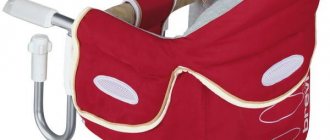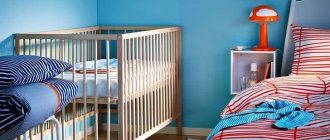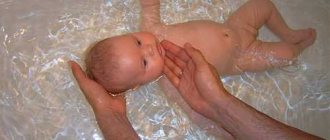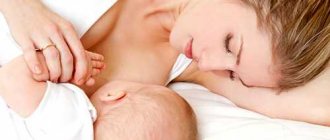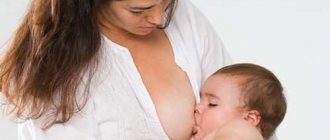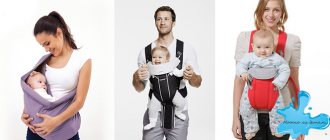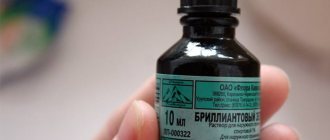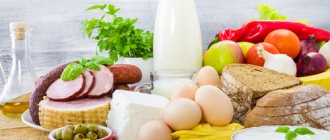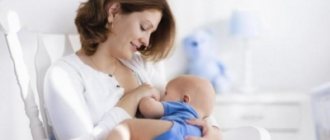Important points when choosing a bottle for newborns
The choice of a bottle for your baby is influenced by several factors that should be taken into account before purchasing:
- Volume. Products with a volume of 100-150 ml are suitable for children from 0 to 5 months. From 5 months purchase with a volume of 200 ml.
- Material. It can be glass, medical silicone, plastic.
- Form. Classic, “anti-colic”, with notches on both sides or wide, repeating the shape of the breast.
- Pacifier. The main factor on which the development of correct bite in a child depends.
How much do you need?
The answer to this question directly depends on what the newborn eats. A bottle-fed baby will need bottles immediately after birth and in large quantities. To feed the baby with the mixture and add water, you need at least 4-6 containers :
- 4 bottles of 250 ml - for feeding with artificial milk formula;
- 2 bottles of 100-150 ml - for water.
Why so much?
The fact is that otherwise it will be difficult to ensure the circulation of dishes, because used containers need to not only be washed, but also sterilized. And free, clean bottles should always be available for preparing the mixture. You can drink water from a smaller bottle. In this case, a couple of pieces will be enough - while one is being processed, the other can be used to give the baby something to drink.
For a breastfed baby, buy two bottles:
- 1 container of 250 ml (perhaps, in the absence of the mother, the baby will need to be fed with expressed milk);
- 1 container per 100 ml (for water and dill seed decoction).
There is an opinion that it is undesirable to offer a baby food from a bottle with a nipple. This method of absorbing liquid requires less effort from the baby.
There is a risk that the baby may subsequently refuse to breastfeed, since it is more difficult to “extract” milk from the mammary gland. If there are such concerns, the baby is fed and watered using a spoon.
Choosing a manufacturer
You should not save money and purchase products from unknown manufacturers. Today, the baby products market offers a wide range of bottles from well-known brands that have stood the test of time.
Nuk from Germany
The German manufacturer has been on the market since 1956. Bottles for feeding newborns are made of glass, silicone, and have different volumes and shapes. The average cost of products is from 300 rubles and above. Accessories are ISO 9001 certified and recommended by leading pediatricians in the world.
Avent and Philips - England
Production is located in the UK. The manufacturer offers bottles with an anti-colic system and regular ones, in different colors and sizes. The brand's products have been on the market since 1986, have international quality certificates and are constantly conducting scientific research in their own laboratory to improve the quality of products for children. The cost of accessories starts from 350 rubles.
Dr. Browns' - USA
Bottles from this manufacturer do not contain polyvinyl chloride. During its work, the brand has earned many international awards and positive reviews from mothers. In 1997, the brand introduced a unique development called “Natural Flow”, which makes artificial feeding as close to breastfeeding as possible. Bottles from this manufacturer cost from 400 rubles and above.
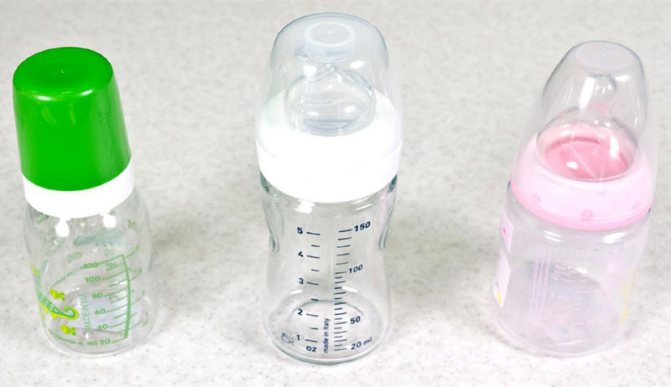
Tommee Tippee - UK
The principle of the UK company founded in 1965 is a responsible attitude towards the health of the child and mother. The brand's products undergo strict quality control at every stage of production and have received European certificates confirming the safety of the products. The cost of bottles starts from 250 rubles.
Material of manufacture
The choice of bottle for a baby and its cost are influenced by the material of manufacture. The market offers products made of glass, plastic and silicone.
Plastic
This material is the most practical and convenient. The bottles are easy to wash, they are light, and cannot be broken. But there are also disadvantages - cracks form on the inner surface with frequent boiling, in addition, they absorb odor and are short-lived.
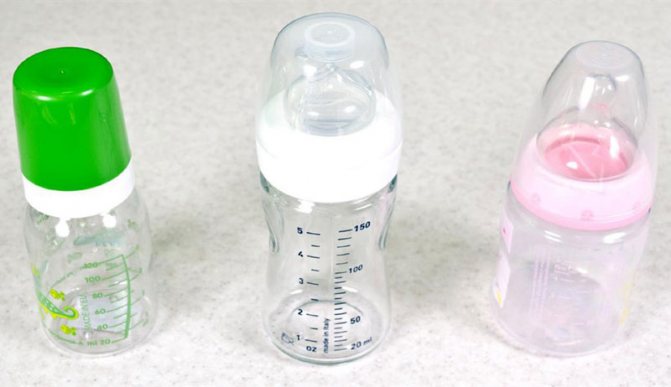
Glass
Glass bottles have a long service life, they do not become cloudy when boiling, and do not absorb odor. When purchasing, you should not choose cheap options; high-quality products from well-known brands are the key to the durability of the bottle and safety for the child.
Among the disadvantages, mothers note that when dropped, the bottle breaks, and in addition, it is too heavy for small children’s hands.
Silicone
Bottles made of medical silicone are not as widespread as products made of glass or plastic, but if you wish, you can purchase this option. They are made of environmentally friendly material and do not change shape or color when boiled.
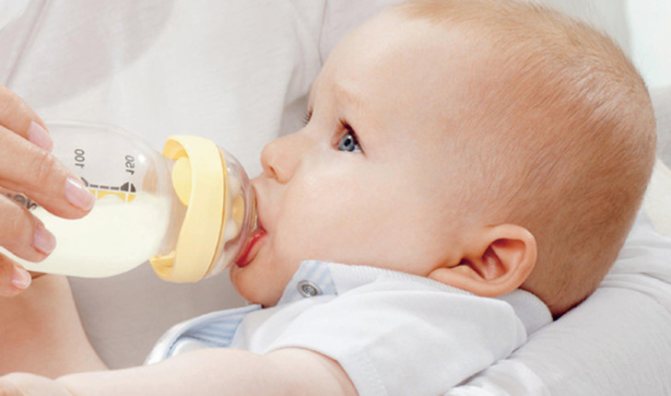
Anti-colic system
Thanks to a special valve, the baby is prevented from swallowing air during feeding, and as a result, the risk of colic in newborns is reduced. At least, that's what the manufacturers say.
Are anti-colic bottles effective?
There is no reliable data, confirmed by scientific experiments, that children fed from a bottle with an anti-colic system are less likely to suffer from colic than those who eat from a regular bottle. The only thing that is really considered an advantage of this system is a more uniform flow of milk thanks to the ventilation system.
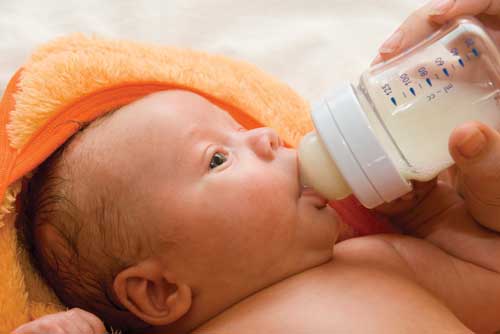
What is a newborn bottle
This is a small bottle (125-330 ml), made of glass or plastic, with a nipple for feeding. Until the child holds a bottle on his own, it is better to buy a glass one. It is easier to sterilize it efficiently - the glass will not burst or deform from longer boiling. And while the child is small and unable to move, he will not be able to break a glass bottle and get hurt.
For slightly older children, you can choose a lightweight plastic bottle that is not afraid of bumps and falls. Since the child’s body is already quite strong at this age, it is enough to pour boiling water over the bottle; long-term sterilization is not required.
In addition to choosing the bottle itself, you also need to choose the right nipple. They come in latex or silicone, of different sizes, configurations and for baby food of different consistencies (the feeding intensity depends on the size and number of holes).
Does the DPT vaccine protect against whooping cough? Find out in this article. How to effectively treat dry cough in children?
What to do if a child has conjunctivitis? https://klubmama.ru/zdorove/detskie-bolezni/konyunktivit-u-rebenka-stoit-li-panikovat.html Read the link.
Child's age
Each brand's line includes bottles designed for a certain age of a newborn. It is not recommended to buy a product “for growth” - it is both inconvenient and unhygienic.
Scaling
Thanks to the scale, the mother has the opportunity to control the amount of food eaten by the baby and make adjustments to the feeding regimen.
Size, volume, shape
The size of the accessory should be comfortable for a child’s small hands. It is better to take the volume so that it is enough for one feeding. The shape of the product can be any: from classic to simulating female breasts.
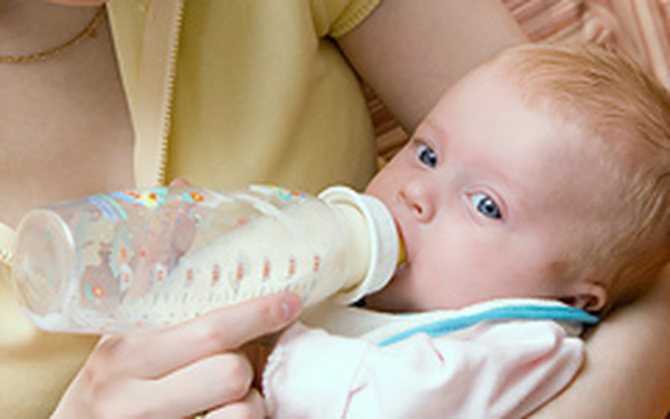
Nipple configuration
Another important selection criterion on which the baby’s health depends. The future bite of a newborn and his taste habits depend on a correctly selected pacifier. As a rule, nipples come immediately complete with bottles and are oval, classic round, orthodontic and anti-colic.
How to choose for bottle-fed babies?
Give preference to convenient and safe options . Don’t be tempted by the cheap price and buy children’s dishes from open market stalls, second-hand, or from dubious retail outlets.
Feeding containers come into contact with food, so it is important to choose a product made from high-quality and harmless materials. Branded bottles are accompanied by a quality certificate. All children's dishes should be made from environmentally friendly materials.
Size and volume of a baby bottle
Formula-fed newborns need 250 ml bottles to prepare the formula. A spacious container will allow you to thoroughly shake the contents to homogenize the prepared mixture. Such bottles will later be useful for a grown-up baby for compote and juice.
Also buy two small bottles, 80-150 ml . From such dishes it is convenient to drink the crumbs with water.
There are bottles with different neck diameters on sale. Wide containers are more suitable for supplementary feeding of babies on natural feeding, since the nipple on such bottles is similar to the nipple of the mother's breast, it is more physiological. This bottle is easier to clean from any remaining mixture or porridge. The disadvantage of branded wide-neck bottles is the need to buy individual nipples.
Which is better, glass or plastic?
- Glass: the most environmentally friendly material. Heat-resistant glass is used to make children's dishes, thanks to which the container is protected from cracks due to sudden temperature changes. These are convenient and hygienic options. These bottles can be thoroughly washed and sterilized. The capacity scale on the glass surface does not rub off or wash off.
High-quality tableware is made of impact-resistant glass.Cheaper options may break faster. This is perhaps one of the disadvantages of glass containers. In addition, the glass bottle is quite weighty, even without contents.
- Plastic: lightweight and convenient plastic bottles are safe if the quality is confirmed by the manufacturer’s certificate. High-quality containers can be doused with boiling water and exposed to high temperatures. If dropped, a plastic bottle will not break. A more plastic material allows you to give the container a physiological, comfortable shape.
Disadvantages: need frequent replacement as over time the surface becomes cracked and stained by food. Do not undergo active sterilization.Cheap plastic releases hazardous substances (bisphenol A) that end up in the baby’s diet. This can happen both during heating and during normal use.
- Tritan : a modern material (a type of plastic) - safe, does not emit toxic substances and can withstand high temperatures. Tritan bottles can be treated with boiling water.
- Silicone : Silicone containers are lightweight and safe.
Such dishes are suitable for richer consistencies (thin porridges and purees). Cons : prone to staining by food components.
Pacifier
Each bottle comes with a matching nipple. For expensive models, you can choose different nipples.
Material
- Silicone : strong, durable and easy to clean pacifiers.
- Latex and rubber : prone to deformation and lose their shape and properties faster. "gives" rubber. More suitable for newborns due to the softness of the material.
A burst or cracked pacifier must be replaced.
Form
Modern manufacturers offer nipples of various configurations, taking into account the physiology of the baby, the sucking mechanism and the shape of the mammary gland. Experiment with different options to find the one that suits you. Please note that when feeding, the baby does not grasp the tip of the nipple, but the extended base.
For supplementary feeding of infants, nipples with a wide base are recommended, imitating a female nipple with an areola.
- Standard spherical : a regular elongated nipple of a uniform shape with a rounded tip. It is often supplemented with a special “skirt” that prevents air from entering along with food.
- Orthodontic : has an asymmetrical flattened tip. This adaptation takes into account the physiology of feeding. The accessory is located in the mouth deeper than a standard nipple, forming the correct bite. By squeezing milk from such a nipple, the tongue moves more naturally. The main thing is to offer the bottle the “right side”.
- Extendable : specially designed accessory for supplementary feeding of infants. The design of the nipple resembles an areola with a nipple. The sucking process also requires effort, as is the case with breastfeeding. The nipple extends during feeding, but this requires the baby to open his mouth wider and make active sucking movements.
- Anti-colic : intended for the prevention and treatment of bloating in artificial babies. Helps with regurgitation, improves the normal functioning of the gastrointestinal tract.
Hole size
Manufacturers produce nipples with different shapes and numbers of holes. This allows you to regulate the activity of sucking movements, the intensity of liquid flow from the bottle, and the ability to use food of different consistencies.
How to determine if you have chosen the right pacifier? If the child does not choke during feeding and does not make extra efforts to empty the bottle, then everything is fine with the holes.
If the nipple is used to feed a newborn, perform a test by inverting the bottle with its contents. Suitable pace: 1 drop of liquid per 1 second . It is important not to shake the container. At first, one small hole (category 0+) is enough. Once your baby is 1 month old, try changing the pacifier. A grown-up baby needs category 1+. This nipple already has two holes.
An older baby needs a nipple with more holes, since the baby sucks and swallows more actively. One hole will tire the baby. The baby will spend a lot of time trying to get food from a bottle, and will end up hungry. If it is noticeable that during feeding the baby’s cheeks sink inward and the bottle empties extremely slowly, then there are few holes in the nipple or they are too small for the consistency of the contents.
When choosing a pacifier, read the manufacturer's recommendations - the number and size of holes correspond to the baby's age and nutritional consistency. The younger the child, the fewer holes, and the size of the holes is minimal . For older babies, nipples with a large number and size of holes are needed. Liquid nutrition will penetrate through small diameter holes. For purees and porridges you need bigger holes.
Scale with divisions
Choose high-quality bottles with an accurate scale. It’s good if there is a capacity indicator with detailed marks on the surface. At home, check the compliance with the specified scale. Using a measuring cup, check how accurate the scale on the utensil is.
If there are differences, then the baby may be malnourished. Additionally, making artificial formula requires precise measurements of water and dry ingredients. Failure to comply with the proportions can cause problems with the gastrointestinal tract .
The scale will be visible longer if the bottle is made of glass. If the marks are worn out, change the container.
Rating of the best bottles for babies
The top 12 includes the best baby bottles, according to parents and pediatricians. They have more advantages than disadvantages; such products are purchased more often than others.
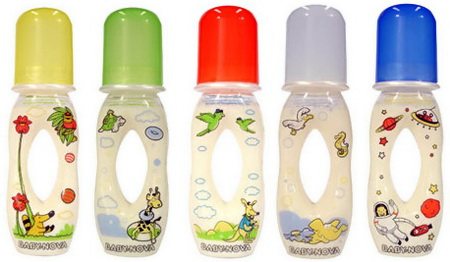
Nuk First Choice
Recommended by pediatricians for feeding infants from birth to 3 months. Made from high-quality polypropylene, safe for child health. The set includes a silicone pacifier, decorated with a funny pattern.
Dr.Brown color
A bottle with a wide neck (which makes it easy to clean) with a volume of 240 ml. Designed for feeding infants up to 3 months. The ventilation system prevents the baby from swallowing air, and the feeding process is as close to natural as possible. Recommended for mothers combining breast and bottle feeding.
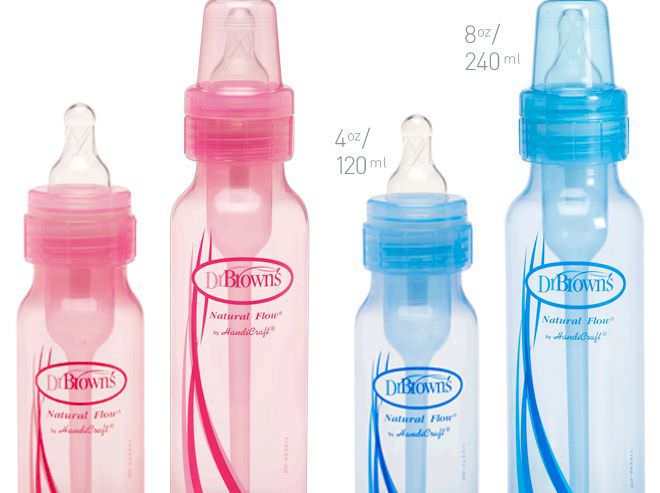
Philips Avent Natural 125 ml
Suitable for feeding babies from birth, it makes it possible to combine breast and artificial feeding; after using it, the child does not refuse the breast. Does not contain bisphenol A and other harmful substances. Supplied complete with pacifier. Can be used up to 6 months of age.
CHICCO Nature Glass 150 ml
Made from heat-resistant natural glass, does not contain harmful components, suitable for feeding babies from the first days of life. The set includes a latex nipple with a special anti-colic valve.
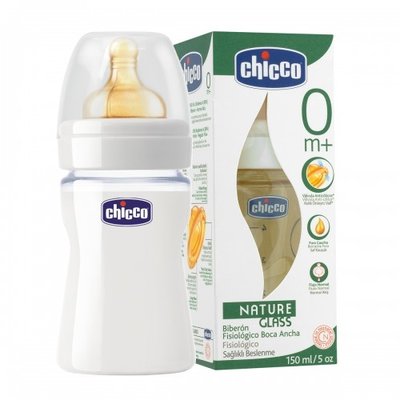
Pigeon
A bottle from Japanese manufacturers hit the Russian market not so long ago, but has already managed to win admirers thanks to the well-thought-out “Peristaltic Plus” system. Suitable for feeding babies from 3 months. The convenient shape of the nipple completely imitates the sensations of a baby during breastfeeding.
Canpol Babies
The Polish manufacturer produces bottles from glass and silicone. The brand's line includes options for children in the first days of life and for the age group from 6 months. Thanks to their consistent quality, the products of this company are one of the most popular among parents.
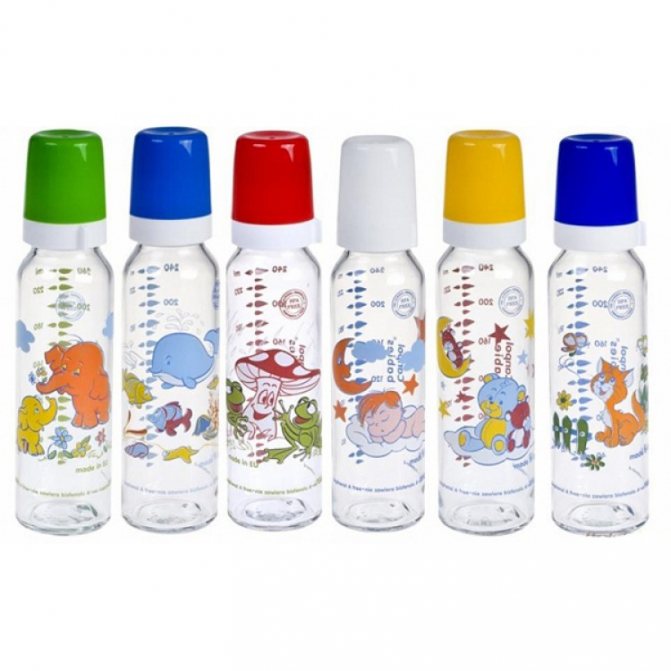
World of Childhood 125 ml “Cow's Stories”
Products from a Russian manufacturer are inexpensive. A bottle can be purchased from 170 rubles. It is equipped with a nipple with a vacuum valve and is easy to clean. According to the manufacturer, it can withstand processing in the microwave oven and dishwasher.
Medela Calma
The famous Swiss quality and unique design of the nipple shape have made this brand a top seller around the world. The product contains no harmful substances, the product is easy to clean, allows you to feed your baby expressed breast milk, and the baby won’t even notice the difference between the bottle and the mother’s breast.
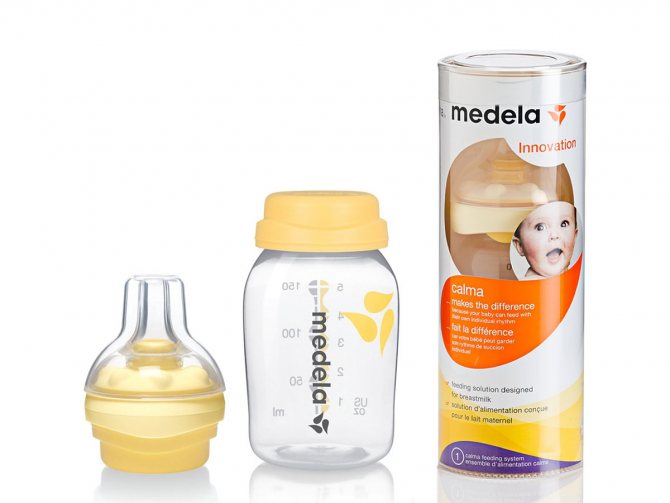
Canpol Haberman & Canpol
The patented development of the Polish manufacturer allows you to forget about colic in a newborn after feeding. The Haberman nipple, made of high-quality silicone, is responsible for this effect.
Tommee Tippee closer to nature
Thanks to the ventilation ring and sensitive anti-colic valve, it is recommended for feeding babies prone to colic. The heat-sensitive tube allows you to control the temperature of the mixture: blue indicates a suitable temperature, red indicates that the mixture needs to be cooled.
Avent natural
An improved children's accessory that allows you to supplement your baby with formula without any problems. The nipple imitates the shape of a female nipple and is equipped with a double valve that prevents air from being swallowed. Used from 0 to 12 months.
How many bottles does a newborn need?
Why is it recommended to have 2 or more bottles? In addition to formula and breast milk, babies need to be given water, especially in hot weather. Therefore, it is recommended to have an additional bottle for these purposes.
If you are fully breastfed, you can feed your baby with a spoon. When bottle-feeding a child, the number of bottles required is at least 3: two for formula and one for liquid. The artificial mixture is prepared for future use, stored in the refrigerator and heated as needed. At night, a newborn may ask to eat 2 or 3 times.
Naturally, preparing the formula every time is long and inconvenient - the child cannot wait long. Therefore, the number of bottles just for the formula is at least two, and some parents purchase 3-4 pieces for their peace of mind.
